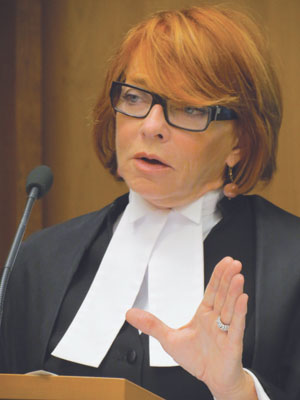When Howard Spiegler began to practise law in the United States, very few people had ever heard of prosecuting someone for war-related art or cultural property theft.

In fact, Spiegler said he often had to convince museums and art galleries that the owners of stolen artwork or other cultural property had the right to reclaim their goods if they had purchased them, knowingly or unknowingly, following significant events like the Second World War.
“That was the greatest displacement of art in human history,” said Spiegler, a partner at Herrick Feinstein LLP in New York.
“Nazis confiscated significant amounts of artwork and either destroyed it or sold it to fund their war. When the war finally ended, millions of people came to recover their stolen art, but the government largely turned a cold shoulder.
From my perspective, it is important to help repair what was a larger attempt to eradicate an entire culture. Their artwork is symbolic of larger crimes that need to be solved.”
Spiegler, who co-chairs his firm’s international art law group, said it has taken some victims nearly 60 years to recover artwork stolen from them during the Second World War.
He noted that as more people in countries outside the United States begin to understand that they can reclaim their artwork and other cultural properties, significant legal questions are arising that Ontario lawyers should be aware of.
“If someone can prove they transferred ownership of their artwork to escape from Germany during the war, for example, could they prove the transfer was a product of duress and successfully reclaim their work?” asked Spiegler.
“On the same hand, does one have to exhaust all local remedies before they can bring their claims under international laws? These are trends to watch out for.”
Lawrence Kaye, another partner at Herrick Feinstein who spoke along with Spiegler at a symposium on criminality in the art and cultural property world on June 15 at Osgoode Hall in Toronto, says thefts of such works are also a significant issue for Canada where the illegal trade of antiquities continues to thrive.
“The sad fact is the trade of antiquities still continues to thrive today and a considerable amount of them are trafficked through Canada,” says Kaye.
“But Canada doesn’t have the type of guidelines that would be necessary to considerably prosecute such thefts.”
In Canada, there are no special investigators dedicated to art theft in many police units.
That leaves auction houses and dealers to operate on a policy of honesty when it comes to reporting stolen works, said Monica Dugot, international director of restitution and senior vice president at fine-art auction house Christie’s in New York.
“Cross-border cultural property issues are really becoming key for countries around the world,” Dugot told the symposium.
“And I think the circulation of unrestituted art will continue to represent significant legal issues that everyone, including Canada, will have to grapple with over the next several years.”
In the meantime, Kaye says returning artwork looted through war holds the key to unique aspects of a country’s culture and is an issue that poses interesting legal questions for Canadian lawyers.
“I think one of the moral issues that Canada’s legal system and others around the world will have to wrestle with is whether or not galleries and museums could also be prosecuted for featuring stolen artwork, whether they purchased it knowingly or not,” says Kaye.
“To my knowledge, none have been yet, but it does show people are still looking for solutions to this issue.”
In fact, that issue has cropped up for at least one Canadian university recently.
Concordia University, along with McGill University and the Hebrew University of Jerusalem, started a project following the death of Canadian art gallery owner Max Stern to reclaim several works stolen from him during the Second World War.
While some of the artwork has been reclaimed from museums and galleries across the globe, most haven’t. The university is currently engaged as an executor of Stern’s estate in a lengthy legal battle to see his artwork returned.
“This is going to go on for some time,” Concordia director of special projects and cultural affairs Clarence Epstein told the symposium. “There aren’t the same checks and balances in Canada compared to the United States.”
In fact, the U.S. government, on behalf of the estate, has seized at least one painting connected to Stern.
The “Masters of the Goldsmith Guild in Amsterdam in 1701” was restituted with the help of the Max Stern Art Restitution Project in October 2011.
The painting had been with the Galerie Stern in Dusseldorf, Germany, since 1937 and later moved to the Galerie Heinemann in Wiesbaden before eventually landing in a casino following the Second World War.
The Holocaust claims processing office of the New York State Department of Financial Services eventually helped Concordia and its university partners reclaim the painting as part of Stern’s estate last year.
In total, Concordia and its fellow executors have received nine paintings as part of Stern’s estate since 2006. However, they’re still seeking 30 others.
Ontario Court of Appeal Justice Gloria Epstein, who also spoke at the event, said Canada could do better when it comes to protecting artwork.
“Ensuring people have the ability to retrieve their stolen property is a value that is naturally inherent in our justice system and it’s something we should be fighting to protect.”

 In fact, Spiegler said he often had to convince museums and art galleries that the owners of stolen artwork or other cultural property had the right to reclaim their goods if they had purchased them, knowingly or unknowingly, following significant events like the Second World War.
In fact, Spiegler said he often had to convince museums and art galleries that the owners of stolen artwork or other cultural property had the right to reclaim their goods if they had purchased them, knowingly or unknowingly, following significant events like the Second World War.